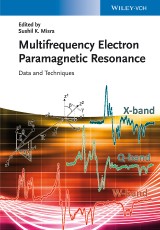Details

Multifrequency Electron Paramagnetic Resonance
Data and Techniques2. Aufl.
|
124,99 € |
|
| Verlag: | Wiley-VCH |
| Format: | EPUB |
| Veröffentl.: | 19.03.2014 |
| ISBN/EAN: | 9783527672455 |
| Sprache: | englisch |
| Anzahl Seiten: | 320 |
DRM-geschütztes eBook, Sie benötigen z.B. Adobe Digital Editions und eine Adobe ID zum Lesen.
Beschreibungen
This handbook is aimed to deliver an up-to-date account of some of the recently developed experimental and theoretical methods in EPR, as well as a complete up-to-date listing of the experimentally determined values of multifrequency transition-ion spin Hamiltonian parameters by Sushil Misra, reported in the past 20 years, extending such a listing published by him in the Handbook on Electron Spin Resonance, volume 2. This extensive data tabulation makes up roughly 60% of the book`s content. It is complemented by the first full compilation of hyperfine splittings and g-factors for aminoxyl (nitroxide) radicals since 197 by Larry Berliner, a world expert on spin labeling, helping to identify and interpret substances and processes by means of EPR techniques. The book also includes coverage of the recently developed experimental technique of rapid-scan EPR by Sandra Eaton and Gareth Eaton, and a thorough review of computational modeling in EPR by Stefan Stoll, author of Easy Spin.
Chapter I. Introduction<br> Sushil K. Misra<br> <br> Chapter II. Rapid Scan Electron Paramagnetic Resonance <br> Sandra S. Eaton, Richard W. Quine, Mark Tseitlin, Deborah G. Mitchell, George A. Rinard, and Gareth R. Eaton <br> <br> Introduction <br> Post-acquisition treatment of rapid-scan signals<br> Simulation of rapid-scan spectra<br> Scan coils <br> Design of scan drivers<br> Use of ENDOR type coils and RF amplifiers for very fast scans<br> Resonator design<br> Background signals<br> Bridge design<br> Selection of acquisition parameters<br> Multifrequency rapid scan<br> Example of applications<br> Extension of the rapid-scan technology to scans that are not fast relative to relaxation times<br> Summary<br> <br> Chapter III. Computational modeling and least-squares fitting of EPR spectra<br> Stefan Stoll<br> <br> Introduction<br> Software<br> General principles<br> Static cw EPR spectra<br> Dynamic cw EPR spectra<br> Pulse EPR spectra<br> Pulse and cw ENDOR spectra<br> Pulse DEER spectra<br> Least-squares fitting<br> Various topics<br> Outlook<br> <br> Chapter IV. MULTIFREQUENCY TRANSITION-ION DATA TABULATION<br> Sushil K. Misra, Sean Moncrieff, and Stefan Diehl<br> <br> Introduction<br> Listing of spin-Hamiltonian Parameters<br> References<br> <br> Chapter V. COMPILATION OF HYPERFINE SPLITTINGS AND g-FACTORS FOR AMINOXYL (NITROXIDE) RADICALS<br> Lawrence J. Berliner<br> <br> Introduction<br> Tabulations<br> References<br>
Sushil Misra has done extensive experimental and theoretical research in the area of electron spin resonance (ESR) for the last 28 years. Currently, he is a collaborating faculty member at the Advanced Center for Electron Spin Research technology at Cornell University. He has written many review articles and book chapters on the subject and published over 225 papers in refereed journals in the field of ESR. As a specialist frequently invited to international conferences and his involvement with the International EPR Society he not only contributed a significant portion to the Handbook on Electron Spin Resonance, volume 2, but also published another book with Wiley-VCH entitled "Multifrequency Electron Paramagnetic resonance: Theory and Applications", covering a large number of recently developed main topics in ESR.<br> <br> With a background in physics, chemsitry, and bio-chemistry the author team combines a strong expertise in developing EPR instrumentation and applying it to condensed matter, proteins, and even for in-vivo studies.
<p>This handbook is aimed to deliver an up-to-date account of some of the recently developed experimental and theoretical methods in EPR, as well as a complete up-to-date listing of the experimentally determined values of multifrequency transition ion spin Hamiltonian parameters by Sushil Misra, reported in the past 20 years, extending such a listing published by him in the Handbook on Electron Spin Resonance, volume 2. This extensive data tabulation makes up roughly 60% of the book‘s content. It is complemented by the first full compilation of hyperfine splittings and g-factors for aminoxyl (nitroxide) radicals since 1976 by Larry Berliner, a world expert on spin labeling, helping to identify and interpret substances and processes by means of EPR techniques. The book also includes coverage of the recently developed experimental technique of rapid-scan EPR by Sandra Eaton and Gareth Eaton, and a thorough review of computational modeling in EPR by Stefan Stoll, author of Easy Spin.</p> <p>From the contents:<br /> • Introduction<br /> • Rapid-Scan Electron Paramagnetic Resonance<br /> • Computational Modeling and Least-Squares Fitting of EPR Spectra<br /> • Multifrequency Transition Ion Data Tabulation<br /> • Compilation of Hyperfi ne Splittings and g-Factors for Aminoxyl (Nitroxide) Radicals</p>


















